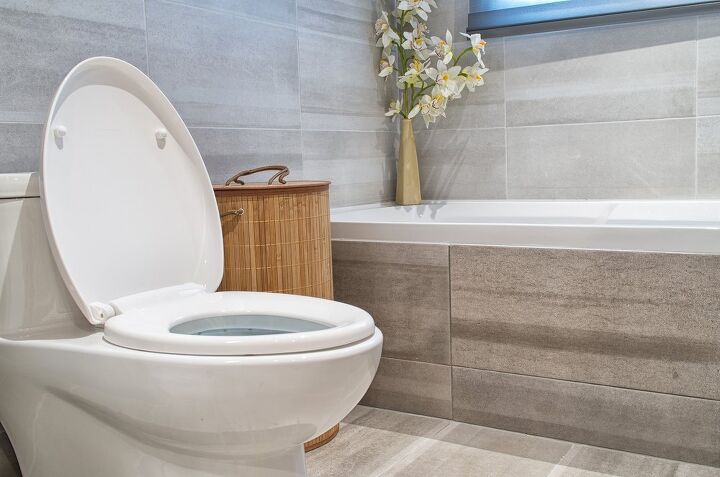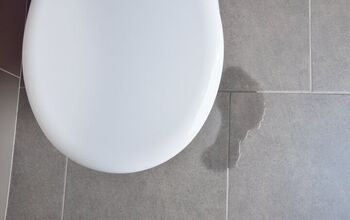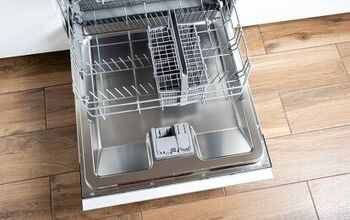Toilet Bubbles When Washer Drains? (Possible Causes & Fixes)

If while running your washer you hear a toilet or sink making a gurgling sound, it’s likely air has reached a spot in the pipes where it shouldn’t be. If the gurgling sound is absent and instead your toilets and sinks bubble when the washer runs, it’s likely misplaced air is again the culprit.
A variety of things can cause improper airflow in pipes. But if activating the washer is specifically what causes other plumbing fixtures to gurgle and bubble, it’s almost certain that the problem is directly related to the washer.
In this article, the things that cause a washer to affect toilets and other plumbing fixtures will be discussed in detail. Some solutions and preventative measures will be addressed as well.
If your toilet is bubbling and gurgling when the washer is running, such is most likely an indication that there’s an obstruction somewhere in a pipe that both fixtures share. Bubbling and gurgling are the results of trapped air escaping from the pipe, and usually air only goes backward when there’s a block. Identifying the source of the block is step one and then removing it is step two.
Do You Need to Hire a Plumber?
Get free, zero-commitment quotes from pro contractors near you.

How a Washer Is Supposed to Work
Before you can identify washer-related problems, you need to first understand how a washer is supposed to work. This is why a brief explanation of how a washer works is included below.
Think of the washer as a giant drum. When you put your clothes in this drum, they will first be tossed around in soapy water, and then the drum will spin rapidly to wring your clothes of the soapy water.
But there are actually two drums in a washer, an inner drum and an outer drum. The inner drum is where you put your clothes. It has a lot of small holes in it, and these are there so the water can get in and out.
Two washer styles are common throughout the world, but one style is mostly used in Europe while the other is mainly used in the U.S. and Asia. Both styles are briefly explained below.
European Washers
European washers utilize doors, unlike American and Asian washers which utilize lids. European washers are horizontally mounted, which means they spin like car tires. Inside these washers there are several paddles, and these move the clothes around.
American/Asian Washers
American and Asian washers are top-loading machines, and their inner drums don’t utilize multiple paddles like the European models do. Instead, these vertically mounted drums utilize one paddle in the middle—known as an agitator—to spin the clothes. And unlike the inner drums in European washers, vertically mounted inner drums don’t move.
The second drum, known as the outer drum, is not visible unless you take the machine apart. This drum is what holds the water while the inner drum rotates, but this drum—unlike the inner drum—has to be watertight. If it wasn’t, the washer would be an ever leaking machine.
Other Important Washer Components
While the two drums are the largest components in a washer, there size doesn’t necessarily make them the most important components. There are other important components, and each one is listed and briefly described below.
- The Thermostat: This tests the temperature of incoming water.
- The Heating Element: This heats the water.
- An Electrically Operated Pump: This removes the water from the drum when washing has concluded.
- The Programmer: This is either mechanical or electrical, and this component essentially tells the washer what to do and when, i.e. rinse, drain, spin.
The Role Piping Plays
As far as piping goes, there are two intake pipes, one for clean hot water and one for clean cold water. A washer also utilizes a third pipe, and through this pipe dirty water is flushed out after washing has concluded.
All these pipes have shutoff valves, and when activated water is prevented from entering the pipes. But the pipes a washer utilizes are in some way going to be connected to other plumbing fixtures in the home, and such is why gurgling and bubbling can manifest in other plumbing fixtures when the washing machine is malfunctioning.
Reasons Behind Washer-Based Toilet Bubbling
Unfortunately, one issue alone doesn’t cause this problem. Several things could explain the gurgling and bubbling, and a few of these problems aren’t even washer-specific. Three common causes are listed and briefly explained below. If your toilet or another plumbing fixer is gurgling/bubbling when the washer runs, one or more of these causes could be what you’re facing
There May Be a Partial Clog
If the washing machine’s main drain is clogged, then a gurgling sound can manifest, not only in the washing machine but in other plumbing fixtures as well. The washer’s drain being restricted will force both air and water back through the pipe the wrong way.
If the block is not complete, there will still be some water movement and airflow. Both will be significantly reduced, however.
When wastewater and trapped air become backflow, the sinks in your home probably won’t be affected (at least not right away). The bathtub/shower, on the other hand, will probably serve as the first exit for trapped air and water. Again, the gurgling and bubbling are direct results of air escaping the pipes.
Connected Drains
Connected drains may also cause gurgling and bubbling, but the thing to point out here is that the gurgling may not manifest when the washer drains but instead when it is in the process of washing clothes. If the washer is between the soil stack and the toilet, the washer’s drain may be connected to the toilet drain, and this connection can sometimes cause the gurgling noise.
It could also be that the washer and the toilet share the same stack, and if this is the case then the washer and the toilet will share the same vent stack too. If the vent stack becomes obstructed in some way, gurgling and bubbling are key indications of this. When gurgling and bubbling are caused by a blocked vent, the problem is known as wet venting.
Blocked Vent Stack
It’s already been said that a blocked vent stack can cause plumbing fixtures to gurgle and bubble, but why is this? When there’s some kind of block—even a minor one—negative pressure is created. This negative pressure will pull air from all possible openings, and this is specifically what causes the gurgling and bubbling.
Water is supposed to form a seal in the pipes. As it moves, it pushes the air in the pipes while creating a vacuum in its wake. The vacuum is so strong that it can draw air through a flushing toilet, and this is what creates the gurgling sound.
Note: Keep in mind, however, that toilet gurgling—when no other fixture is involved—could be because of a problem unrelated to the vent stack.
How the Toilet’s P-Trap Is Involved
In some instances, the vacuum may be so strong that it pulls water out of the toilet’s P-trap, and when this happens you’ll immediately smell a foul odor—that’s sewer gas filling the space where water once was in the P-Trap. Other P-Trap problems could cause this smell to manifest, so don’t immediately assume there’s a venting issue if you get a whiff of something foul.
If you already suspect there’s a venting issue, and then you notice the aforementioned P-trap problem, it’s almost certain that there’s a block somewhere in the vent stack. It’s likely this problem will only be resolved with help from a professional plumber, as most homeowners don’t have the know-how and tools necessary to deal with clogged vent stacks on their own.
What to Do When the Vent Stack Is Blocked
The vent stack is a vertical pipe that goes through the roof, and usually these stacks are coverless. Since the opening is exposed, leaves and other debris can find their way into the vent stack, creating a clog. But in this instance, removing the clog won’t be tough, provided the leaves are in a spot that can be reached.
It could also be that a bird or some other small animal has made the vent stack their home, and in this case removal may be more difficult. This is common in colder climates, as the vent stack is warm and therefore an attractive spot for critters that want to get out of the cold.
The vent stack must be free of obstructions. If it’s not, air will not be able to flow freely. Airflow isn’t important for fixtures like tubs and sinks, as they don’t require a lot of pressure. But toilets and washers definitely need good airflow to work properly.
Do You Need to Hire a Plumber?
Get free, zero-commitment quotes from pro contractors near you.

Related Questions
Can a washer drain malfunction cause bubbling and gurgling?
It’s been established already that a washer drain block can lead to bubbling and gurgling in other plumbing fixtures, and this is why one should take all available measures to dislodge the clog when they first notice it. It may be that your washing machine was not installed properly or you haven’t been conducting routine maintenance.
Is vent stack clog removal a DIY task?
Most homeowners can’t do vent stack clog removal on their own because they lack the know-how and tools required. But if you do have what’s needed, go ahead. Just make sure you don’t turn a minor block into significant plumbing system damage.

Matt loves everything DIY. He has been learning and practicing different trades since he was a kid, and he's often the first one called when a friend or family member needs a helping hand at home. Matt loves to work with wood and stone, and landscaping is by far his most favorite pastime.
More by Matthew Mountain



























